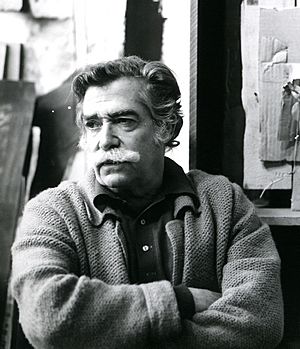Antoni Clavé facts for kids
Quick facts for kids
Antoni Clavé
|
|
|---|---|
 |
|
| Born | 5 April 1913 Barcelona, Spain
|
| Died | 1 September 2005 (aged 92) St Tropez, France
|
| Other names | Clavé |
| Occupation | Artist, costume designer |
| Years active | 1952–1980 |
Antoni Clavé (born April 5, 1913 – died September 1, 2005) was a famous artist from Catalonia, Spain. He was a talented painter, printmaker, sculptor, and designer for theater and movies. He even got nominated for two Academy Awards for his work on the 1952 film Hans Christian Andersen.
Clavé was one of Spain's most celebrated artists. His art changed a lot over time. At first, it was very detailed and decorative. Later, it became simpler and more abstract. In his final years, his art was completely abstract. He used strong lines and explored different ways to combine paint with other materials. He also used textures and colors in new ways.
He studied at the School of Fine Arts in Barcelona. His teachers were Angel Ferrant and Felix Mestres. Other artists like Bonnard, Vuillard, and Roualt also influenced his work. Clavé is especially known for his "lyrical abstractions." These are artworks that mix paint with collage, which means sticking different materials onto the canvas.
Biography
Early Life and Art
Antoni Clavé fought in the Republican Army during the Spanish Civil War. He worked as a draughtsman, which means he drew plans and designs for the government. In 1939, he moved to France as a refugee. He went straight to Paris to work as an illustrator.
His first solo art show was in Paris in 1940. It was held at a bookshop called Au sans Pareil. This was the same place where famous artists like Max Ernst had their first shows years before. In 1944, Clavé met the famous artist Pablo Picasso. Picasso's work greatly influenced Clavé's art. Clavé began to create paintings of kings, harlequins, children, and still life scenes.
Theatrical Work
Clavé was also a talented designer for plays, ballets, and operas. His designs appeared on stages in big cities like New York, Munich, London, and Paris. He also designed costumes and sets for the 1952 film Hans Christian Andersen.
He created sets for many shows, especially for Roland Petit's ballet company. Some of his famous ballet designs include Los Caprichos (1946) and Carmen (1949). In 1951, he designed the set for the play La maison de Bernarda Alba. Later, in 1962, he worked on a production of The Marriage of Figaro.
Later Art and Legacy
In 1957, Clavé started designing carpets. From 1960, he began to create sculptures. These included bas-reliefs, which are sculptures that stick out from a flat surface. He also made assemblages, which are artworks made from different objects. He created totem-like sculptures using wood and lead. Sometimes, he even used "objets trouvés," which are everyday objects found and used in art.
In 1965, Clavé moved to the South of France, near Saint-Tropez. His artworks are displayed in many famous museums around the world. You can find his pieces in places like the Fine Arts Museums of San Francisco and the Tate Gallery in London. His art is also in the Museum of Modern Art, Paris and The British Museum.
See also
 In Spanish: Antoni Clavé para niños
In Spanish: Antoni Clavé para niños

